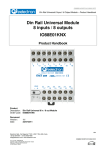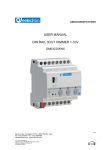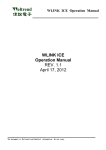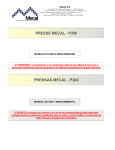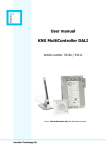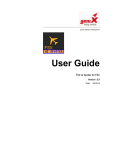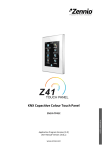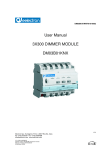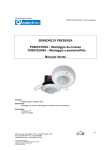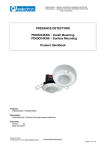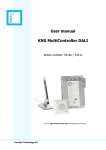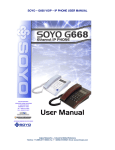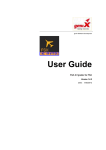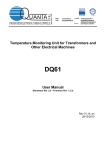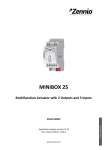Download Manual - Eelectron
Transcript
IO32D01KNXFI01040002.DOCX IO32D01KNX– Product Handbook INWALL 3 INPUT / 2 OUTPUT MODULE IO32D01KNX Product Handbook Product: IO32D01KNX Description: INWALL 3 INPUT / 2 OUTPUT MODULE Document Version: 1.4 Date: 07/01/2014 Eelectron SpA, Via Magenta 77/22, I-20017 Rho (MI), Italia +39 02.9316681 +39 02.93507688 [email protected] www.eelectron.com C.F. e P.IVA 11666760159 Capitale sociale: 800.000,00€ interamente versato Tribunale di Milano 359157-8760-07 CCIAA Milano 148549 1/32 IO32D01KNXFI01040002.DOCX IO32D01KNX– Product Handbook INDEX 1. 2. 3. 4. 5. 5.1. 5.2. 5.3. 5.4. 5.5. 5.6. 6. 7. 8. 9. 9.1. 9.2. 9.3. 9.4. 10. 11. 12. 12.1. 12.2. 12.3. 12.4. 12.5. 13. 14. 14.1. 14.2. 14.3. 14.4. 14.5. 15. 15.1. 15.2. 15.3. 15.4. 15.5. 16. 16.1. 16.2. 17. 17.1. 17.2. 17.3. 17.4. 17.5. 17.6. 17.7. 17.8. 17.9. General Introduction ..................................................................................................................................... 4 Product and functional overview ................................................................................................................... 4 General Parameter Configuration ................................................................................................................. 5 Channels Configuration ................................................................................................................................ 5 Digital input <x> Configuration ...................................................................................................................... 6 Activation on press / edge ............................................................................................................................. 6 Activation short/ long press ........................................................................................................................... 7 Input: Dimming .............................................................................................................................................. 7 Input: Shutter and Blind ................................................................................................................................ 7 Input: Scene Management ............................................................................................................................ 8 Commands in sequence ............................................................................................................................... 8 Temperature Probes ..................................................................................................................................... 9 Temperature Sensor Function ...................................................................................................................... 9 Thermostat Function ................................................................................................................................... 10 Target Setpoint Settings ............................................................................................................................. 10 Two points on/off......................................................................................................................................... 12 On/off with PWM control ............................................................................................................................. 13 Fan coil on/off ............................................................................................................................................. 13 Fan coil control % (or generic continuous control) ..................................................................................... 15 Temperature probe failure / out of range measurement .............................................................................. 15 Behavior of Thermostat on voltage failure, recovery and commissioning. ................................................. 16 Remote control............................................................................................................................................ 17 Remote control configuration................................................................................................................. 18 Activation on press ................................................................................................................................ 18 Scene .................................................................................................................................................... 19 Commands sequences .......................................................................................................................... 19 Special Function for buttons 5,6,7,8 ...................................................................................................... 19 Output Configuration ................................................................................................................................... 20 Generic load control .................................................................................................................................... 20 Function ON/OFF .................................................................................................................................. 21 Timing Functions ................................................................................................................................... 21 Function ON/OFF with delay ................................................................................................................. 21 Function ON with delay/timing OFF....................................................................................................... 22 ON/FF vs Timing Functions ................................................................................................................... 23 Output Additional Functions ........................................................................................................................ 24 Logic Function ....................................................................................................................................... 24 Lock Function ........................................................................................................................................ 24 Scene Function ..................................................................................................................................... 25 Priority table for Output ......................................................................................................................... 26 Behavior of output on voltage failure, recovery and commissioning. .................................................... 26 Electric valve control ................................................................................................................................... 27 Main Parameters ................................................................................................................................... 27 Lock Function ........................................................................................................................................ 28 Output Configuration for shutter .................................................................................................................. 29 Delay on opening and closing ............................................................................................................... 29 Louvers automatic movement ............................................................................................................... 30 Additional Functions .............................................................................................................................. 30 Scene Function ..................................................................................................................................... 30 Lock Function ........................................................................................................................................ 31 Alarm Function ...................................................................................................................................... 31 Shutter position after lock and alarm ..................................................................................................... 31 Priority Table for shutter ........................................................................................................................ 31 Behavior of shutter on voltage failure, recovery and commissioning. ................................................... 32 Eelectron SpA, Via Magenta 77/22, I-20017 Rho (MI), Italia +39 02.9316681 +39 02.93507688 [email protected] www.eelectron.com C.F. e P.IVA 11666760159 Capitale sociale: 800.000,00€ interamente versato Tribunale di Milano 359157-8760-07 CCIAA Milano 148549 2/32 IO32D01KNXFI01040002.DOCX IO32D01KNX– Product Handbook Any information inside this manual can be changed without advice. This handbook can be download freely from the website: www.eelectron.com Exclusion of liability: Despite checking that the contents of this document match the hardware and software, deviations cannot be completely excluded. We therefore cannot accept any liability for this. Any necessary corrections will be incorporated into newer versions of this manual. Symbol for relevant information Symbol for warning Eelectron SpA, Via Magenta 77/22, I-20017 Rho (MI), Italia +39 02.9316681 +39 02.93507688 [email protected] www.eelectron.com C.F. e P.IVA 11666760159 Capitale sociale: 800.000,00€ interamente versato Tribunale di Milano 359157-8760-07 CCIAA Milano 148549 3/32 IO32D01KNXFI01040002.DOCX IO32D01KNX– Product Handbook Digital inputs main functions: 1. General Introduction This manual is intended to be used by installers and describes functions and parameters of the device IO32D01KNX and how is possible to change settings and configurations using ETS software tool. 2. Product and functional overview IO32D01KNX module is designed to be installed in Home and Building installations (i.e. offices, hotels, private houses, etc...). The module includes two digital inputs to interface free potential contacts, one analog input for temperature sensors and two relay output (bistable). Digital inputs are intended to be connected to sensors, traditional buttons, etc; they can be used to on/off commands, dimming, shutter control, scene recall and control, sequences of 3 objects. Analog input, can manage one temperature probe (with On/Off threshold) or one thermostats to control heating and cooling equipments, valves, 2 and 4 pipes fan coils; etc.. 1 bit commands: load activation / deactivation commands (ON/OFF/TOGGLE) with short press or with differentiation of long and short press 1 byte commands (unsigned 0-255 or HVAC commands or value % commands). Sending of long action telegrams on the same address of short action or on a different group address Cyclic sending Sequences (3 commands mixing 1bit/1byte objects) with different group addresses Edges for 1 bit / 1 Byte / sequences Dimmer management (with single or double pushbutton) Blind / Roller Shutter management (with single or double push-button) Scene management Input 2 can be used to drive a LED for signaling when Infrared receiver is configured (IRX) For digital inputs (IN1, IN2): Max. length of Connecting Cable: ≤ 30 m (twisted cable) For analog input (IN 3): Max. length of Connecting Cable: ≤ 20 m (twisted cable) Analog input main functions: Analog input, alternatively to the temperature sensor, can manage a Infrared Receiver (IRX) in order to forward to the bus up to 8 channel coming from a Infrared Remote Control (IRC) with on/off commands, scenes, sequences of 2 objects, dimmer and shutter. Configured as Temperature sensor - main functions: For NTC temperature probe the following eelectron code accessories must be used: Configured as Thermostat - main functions: TS01A01ACC (from -20°C to +100°C) TS01B01ACC (from -50°C to +60°C) Outputs include switching function with timed delays, staircase function, scene recall, lock or logic function. 2 different temperature thresholds to trigger 1 bit telegrams alarm/warning Enable / disable of alarm / warnings via 1 bit object Different control algorithms: 2 point on/off; PWM; Continuous Control / Fan Coil Control Different setting modes: via HVAC automatic / via HVAC Manual / via Setpoint Window contact function Additional external temperature sensors (optional) Device 2 outputs on board can be configured: Each output can be configured independently for load control (2 independent channels) Each output can be configured independently for ON / OFF or continuous switching (PWM) for Electric valves (solenoid actuators) (2 independent channels) Outputs can be configured in pairs for the management of roller shutters and blinds; (1 channel) Eelectron SpA, Via Magenta 77/22, I-20017 Rho (MI), Italia +39 02.9316681 +39 02.93507688 [email protected] www.eelectron.com C.F. e P.IVA 11666760159 Capitale sociale: 800.000,00€ interamente versato Tribunale di Milano 359157-8760-07 CCIAA Milano 148549 4/32 IO32D01KNXFI01040002.DOCX IO32D01KNX– Product Handbook 3. General Parameter Configuration KNX PARAMETER Minimum time long press input SETTINGS 40 ms 80 ms 100 ms 150 ms 200 ms 600 ms 1 sec. When a button connected to the input is pressed it is possible to have the contact opened or closed more than once before fixing into a stable position; this can be caused by a rapid succession of bounces between mechanicals contacts. For this reason it is important to determine a correct value of the parameter “debounce time” to avoid these bounces could be taken by the device as input switching. How this parameter works: after the device has detected a change of status for an input channel, it waits for a time equal to the time set as “debounce time” before updating the value of the corresponding data point. The input signal is not evaluated during this time. Input debounce time This parameters affects all 8 device input channels (where present) Determines how long must be a press to be considered long; if shorter than the selected value the press will be considered short. 4. Channels Configuration It’s possible to configure two inputs to work together by selecting the value “combined” in “Channel Configuration” page. KNX PARAMETER Inputs 1 and 2 SETTINGS Single Combined Single: each channel can be configured independently Combined: IN1 and IN2 combined to perform dimmer or shutter/blind function Delay on Power-up 5 ÷ 15 seconds Through this parameter is possible to set the delay of transmission of telegrams after a power on by selecting the time by which the device is allowed to send telegrams. In large systems after a power failure or shutdown this delay avoids to generate excessive traffic on the bus, causing slow performance or a transmission block. If there are different devices requiring sending telegrams on the bus after a reset, these delays must be programmed to prevent traffic congestion during the initialization phase. The input detection and the values of objects are updated at the end of the transmission delay time At the end of ETS programming the device behaves like after a power on. KNX PARAMETER Analog input 3 SETTINGS Temperature sensor Thermostat “Temperature Sensor”: measures and sends temperature on the bus “Thermostat” : controls different types of actuators regulating heating and cooling Eelectron SpA, Via Magenta 77/22, I-20017 Rho (MI), Italia +39 02.9316681 +39 02.93507688 [email protected] www.eelectron.com C.F. e P.IVA 11666760159 Capitale sociale: 800.000,00€ interamente versato Tribunale di Milano 359157-8760-07 CCIAA Milano 148549 5/32 IO32D01KNXFI01040002.DOCX IO32D01KNX– Product Handbook KNX PARAMETER 5. Digital input <x> Configuration For each of the 2 input channels, present on the device, the selections are made through a configuration page. Every single channel or input can be configured to perform one of the following functions: Activation on press Activation on short and long press Dimming Shutter and blinds Scene Command in sequence (on short and long press) Command in sequence (on edge) KNX PARAMETER Function SETTINGS Activation on press Activation on short and long press Dimming Shutter and blinds Scene Command in sequence (short/long press) Command in sequence (on edge) Activation on press see par. 5.1- Activation on press/edge Activation on short and long press see par. 5.2-Activation short/ long press Dimming see par. 5.3- Dimming Shutter and Blind see par. 5.4- Shutter and Blind Scene see par. 5.5 - Scene Management Command in sequence see par. 5.6 - Command in sequence Telegram Associated Activation on press / edge The "Activation on edge " allows you to configure the sending of telegrams when the state of the contact switch from open to close and vice versa. You can set to send a telegram with different values associated with different edges, or decide to send commands only one of the two edges 1 byte 1 bit It is possible to send 1 bit or 1 byte objects Configurations for 1 bit object in events of closing or opening contact: Nothing (no telegram) On Off Toggle Configurations for 1 bit object in events of closing or opening contact: Value 0-255 (generic signed int) Value o-100% (scaling value in steps of 5%0) HVAC Mode value (according to DPT_HVACMode 20.102) o AUTO o COMFORT o STANDBY o ECONOMY o BUILDING PROTECTION KNX PARAMETER SETTINGS on contact open / close on contact open / close, cyclic if opened Telegram sending 5.1. SETTINGS on contact open / close, cyclic if closed on contact open / close and always cyclic With the "Activation of the press / edge" selection device can also be configured to send periodic messages with repetition period. Eelectron SpA, Via Magenta 77/22, I-20017 Rho (MI), Italia +39 02.9316681 +39 02.93507688 [email protected] www.eelectron.com C.F. e P.IVA 11666760159 Capitale sociale: 800.000,00€ interamente versato Tribunale di Milano 359157-8760-07 CCIAA Milano 148549 6/32 IO32D01KNXFI01040002.DOCX IO32D01KNX– Product Handbook Note 1: When periodical sending is enabled for one only of the two edges, switching in the state where "no telegram" is associated causes the periodic sending stop. Note 2: If you want to handle both instant sending and periodic sending on only one of two fronts without performing an action on the other, for this you must select the option "no telegram". Note 3: If you connect an input to a wind, rain or frost sensor with dry contact output you should probably set the parameter "mode sending telegrams" as " Immediate & cyclic on open/close" in order to have the periodic sending of telegrams . (Check telegrams value and time expected from the actuator controlled by the sensor). Enabled Disable Feedback object Can be used when push button is set as “1 bit – Toggle” in order to have always the status of actuator updated. Send Telegram power up on Enabled Disable With this parameter it is enabled the sending of the status of the switch without having to wait for a change of front; a telegram is sent accordingly to the open / close state of the contact. Note 1: If you enable the sending of the telegram for an input where you have already set the cyclic sending ; then the cyclic sending will start automatically at power on; at the end of the first period. Note 2: If the command selected is “TOGGLE”, the first value sent is always 1 because the CO value on power on is 0. 5.2. Activation short/ long press The difference duration between short and long press is defined by the generic parameter "Minimum time for long press input <x>”. You can set to send a telegrams with different values on short and long press or decide to send commands only on one of this events. When contact is closed and the debounce time is over then counting time to contact closure starts; if the contact is opened again (note that debounce time is considered also in contact opening) before time exceeds TPL time, device executes the command associated with the event of "short press" and if, on the contrary, TPL timeout expires and contact is still closed then the command associated with the event of "long press” is executed. The parameters and mode of transmission of telegrams can be managed through "activation on long and short press" are the same set with the configuration "Activation of press (edge)" to the exclusion of the function of cyclic sending that is not provided here. 5.3. Input: Dimming Through the dimming function it’s possible to control a light dimmer using short & long press of a push button connected to the input channel. Each channel uses 2 communication objects: 1 bit dimension for ON /OFF command associated to short press operation 4 bit dimension for brightness regulation associated to long press operation 5.4. Input: Shutter and Blind Through the Shutter and Blind function it’s possible to control Roller Shutters or Blinds using short & long press of a push button connected to the input channel. Each input uses 2 communication objects: 1 bit dimension for STEP /STOP command associated to short press operation 1 bit dimension for UP / DOWN command associated to long press operation Eelectron SpA, Via Magenta 77/22, I-20017 Rho (MI), Italia +39 02.9316681 +39 02.93507688 [email protected] www.eelectron.com C.F. e P.IVA 11666760159 Capitale sociale: 800.000,00€ interamente versato Tribunale di Milano 359157-8760-07 CCIAA Milano 148549 7/32 IO32D01KNXFI01040002.DOCX IO32D01KNX– Product Handbook 5.6. 5.5. Input: Scene Management In this configuration page it’s possible to set the input channel for scene management: learn and recall scene commands. These different behaviour (recall and learn) are performed through two different actions (short and long press) of a push button connected to the input channel. Learn scene on long press action is enabled by a parameter. KNX PARAMETER SETTINGS Number of the scene: 0 ÷ 63 Scene Number Commands in sequence The function allows you to associate to short and long press, sequences of different commands on the bus. For inputs this function is available for short and long press or for edges evaluation. The sequence consists of 2 or 3 commands which can each be sized as 1 bit or 1 byte. Once defined the number of elements in the sequence (2 or 3) and their size (1-bit / 1 byte), you can associate different commands to each element of the sequence or decide to send commands only on one of the two events. The waiting time between a command and the next is fixed in 1 second. Each object communication can be connected to a different group address. For example it is possible to define a sequence: Command Dim. Store scene press on long Command on long press (edge) A 1 bit ON ( to actuators) OFF (to actuators) B 1 byte 100% (to a dimmer) 0% (to a dimmer) C 1 byte COMFORT (to a thermostat) ECONOMY (to a thermostat) This parameter sets the value of the scene you intend to learn / recall (one per channel). Remember that output devices (i.e. actuators, etc.) generally can manage several scenes, each identified by a value (that varies from 0 to 63); therefore is important to set this parameter correctly and matching the number set on the actuators. Command on short press (edge) Disable Enable If disable, long press action is ignored and no telegram is sent to the bus; if enable on long press action a learn scene telegram is sent to the bus. Enable object learn scene Disable Enable If this parameter is enabled you have a communication object (size = 1 bit). When this object receives a telegram "1" then the function associated to the long press of the button (send the telegram storage scenario) is enabled, when it receives a telegram "0” the command associated with the long press is not sent. Eelectron SpA, Via Magenta 77/22, I-20017 Rho (MI), Italia +39 02.9316681 +39 02.93507688 [email protected] www.eelectron.com C.F. e P.IVA 11666760159 Capitale sociale: 800.000,00€ interamente versato Tribunale di Milano 359157-8760-07 CCIAA Milano 148549 8/32 IO32D01KNXFI01040002.DOCX IO32D01KNX– Product Handbook 6. Temperature Probes NTC temperature probe eelectron code TS01A01ACC or TS01B01ACC. TS01A01ACC (from -20°C to +100°C) TS01B01ACC (from -50°C to +60°C) Max. length of Connecting Cable: ≤ 20 m (twisted cable) TS01A01ACC 7. Temperature Sensor Function The temperature probe allows a reading of the temperature within its range with resolution 0.1 ° C. KNX PARAMETER SETTINGS -1,5°C ÷ +1.5°C with Temperature sensor resolution, 0,1°C calibration It's 'possible to add an offset to the temperature value measured by the probe before it is sent on the bus or made available for reading. Temperature sending cyclic Disable Enable It's 'possible to enable the periodic sending of measured temperature value, if this option is disabled, reading can be done only on read-request. Dimensions in millimetres NTC resistence tolerance: ± 3% Measure range -20°C ÷ +100°C Cable: 2 wire single insulation Cable colour: Black NTC colour: Black Warning: keep at least 6 mm from all live parts L2 = 49 mm L1 = 1250 mm NTC resistence tolerance: Measure range -50°C ÷ +60°C Cable: 2 wire double insulation Cable colour: White NTC colour: White KNX PARAMETER SETTINGS Enable threshold T1 Disable (low) Enable You can also enable two thresholds for temperature and, for each thresholds, send a telegram of attention (of size 1 bit) whenever the measured temperature exceeds or falls below the threshold. For each threshold can be set whether to send the telegram "1" when the measured temperature "T" exceeds the threshold temperature "Tx" and then send the telegram "0" when the measured temperature "T" becomes less than the threshold temperature "Tx "or vice versa TS01B01ACC D1 = 9 mm D2 = 4 mm 1 min 30 min 5 min 1h Sending interval 10 min 4h 15 min 12 h 45 min 24 h If you enable the periodic sending the sending interval is set by this parameter. ± 2% Warning: keep at least 3 mm from all live parts Enable threshold T2 Disable (high) Enable See description of “Enable threshold T1 (low)”. Value threshold T1 -15°C ÷ +55°C Value threshold T2 Telegram to send when T < T1 Telegram to send when T > T2 Object enable for Trigger 1 and 2 -15°C ÷ +55°C Telegram “0” Telegram “1” Telegram “0” Telegram “1” Hide Show Eelectron SpA, Via Magenta 77/22, I-20017 Rho (MI), Italia +39 02.9316681 +39 02.93507688 [email protected] www.eelectron.com C.F. e P.IVA 11666760159 Capitale sociale: 800.000,00€ interamente versato Tribunale di Milano 359157-8760-07 CCIAA Milano 148549 9/32 IO32D01KNXFI01040002.DOCX IO32D01KNX– Product Handbook value enable 0 1 Allows to initialize enable object as active (1) or inactive (0) after power on, reset or download. 8. Thermostat Function The temperature sensor can be configured as a thermostat to control the temperature of a room or area by driving heating or cooling equipment / air conditioning fan coils / valves or through commands on / off to heating /cooling elements such as radiators, heat pumps, split, etc. .. The thermostat operates temperature in a range from -50 ° C to + 100 ° C with 0.1 ° resolution. Setpoint values sent to the device on the bus are accepted in a range from 10°C to 35°C (from 10°C to 50°C from serial number 00048489) Setpoint accepted in SETPOINT MODE are in a range from 0°C to 35 °C from 10°C to 50°C from serial number 00048489) Using the object HVAC MODE (1 byte size), you can set the thermostat in one of the following modes: OFF; ECONOMY; STANDBY; COMFORT; each mode is associated with a setpoint set by a ETS parameter. OFF mode is associate to setpoint antifreeze in heating mode and high temperature protection in cooling mode. HVAC MODE object (automatic heat / cool) Behaviour for this value of parameter “Thermostat control mode” is the same as above described but the switching from heating to cooling mode and vice versa is automatic. With this setting it is necessary to set an insensitive zone as in parameter “Dead zone”. Whenever temperature becomes greater than : Setpoint comfort heating + (Dead Band / 2) active control is cooling; when temperature becomes less than: Setpoint comfort cooling - (Dead Band / 2) active control is heating. SETPOINT Heat protection (Off) Economy Cooling COOLING Initial object HVAC MODE object (switched heat / cool) Standby Cooling Comfort Cooling DEAD BAND Comfort Heating HEATING It's 'possible to enable/disable the remote temperature sensor with a communication object. When this object is enabled and receives a telegram "1" the temperature probe is active and sends trigger telegrams according to thresholds T1 and T2 values; otherwise only temperature value is periodically sent. Standby Heating Economy Heating 9. Target Setpoint Settings Antifreeze (Off) The control setpoint can be changed by bus in two different ways, via one of these objects: COMF STBY HVAC Mode SETPOINT Mode The right policy to adopt depend from the device that acts as a master, a time thermostat, a control panel or a SW supervisor. Here the list of object for changing the active mode or setpoint value by bus. SETPOINT MODE object When "Thermostat control mode" parameter is selected with the value SETPOINT MODE, object HVAC Mode is no longer visible. Each time the thermostat receives a value on object SETPOINT MODE ( 2 byte size), it is used as setpoint for temperature control. ECO OFF HVAC SETPOINT COMFORT object SETPOINT STANDBY object SETPOINT ECONOMY object These 2 byte objects are used to set the setpoint values for COMFORT, STAND-BY, ECONOMY mode. Whenever change, the setpoint are in saved in memory. After download these setpoint are reset to values according to ETS parameter; on power up these object are set according to last values before power down. Use these communication objects to change current setpoint for every HVAC Mode according to the current active control (heating or cooling) Eelectron SpA, Via Magenta 77/22, I-20017 Rho (MI), Italia +39 02.9316681 +39 02.93507688 [email protected] www.eelectron.com C.F. e P.IVA 11666760159 Capitale sociale: 800.000,00€ interamente versato Tribunale di Milano 359157-8760-07 CCIAA Milano 148549 10/32 IO32D01KNXFI01040002.DOCX IO32D01KNX– Product Handbook SETPOINT OBJECTS Telegram received on: Setpoint changed: COMFORT ( OBJ # 31) Setpoint comfort heating STANDBY ( OBJ # 30) Setpoint standby heating ECONOMY ( OBJ # 29) Setpoint economy heating COMFORT ( OBJ # 32) Setpoint comfort cooling STANDBY ( OBJ # 33) Setpoint standby cooling ECONOMY ( OBJ # 34) Setpoint economy cooling If the telegram received indicates that the window is opened thermostat change its mode or setpoint after 1 minute from the reception of the telegram. When it receive a telegram corresponding to state “window closed” it restores the previous mode, always with a delay of 1 minute . The value of SETPOINT ADJUSTMENT (if enabled) is always restored. SETPOINT ADJUSTMENT object COMFORT object ADDITIONAL TEMPERATURE object COMFORT object (1 bit size) is visible only when "Thermostat control mode" parameter is selected with the value HVAC MODE. When a telegram "1" is received thermostat goes in COMFORT mode (it applies for both heating and cooling) On receipt of a telegram "0", thermostat returns to the mode set by HVAC MODE object. COMFORT mode can be set also with timing: after a time set by a parameter thermostat returns in the previous mode. KNX PARAMETER SETTINGS Comfort Object Time limited Time unlimited Comfort Overwrite Time 1.. 255 (minutes) WINDOW CONTACT object This object, if enabled, has higher priority than HVAC MODE, SETPOINT MODE, COMFORT objects. When a telegram is received ("0" or "1") on the communication object WINDOW CONTACT thermostat enters a power saving mode: The object SETPOINT ADJUSTMENT allows you to temporarily change the setpoint value used by the thermostat applying an offset to the current value. If the thermostat is operating in "HVAC MODE" the offset value is applied from the time of receipt of a valid telegram on object SETPOINT ADJUSTMENT until this value does not change, even in case of change of the active mode (Comfort and Standby only); this does not happen with regard to Economy mode and Building Protection: in this modes the value of object SETPOINT ADJUSTMENT is forced to 0. Similarly, if the thermostat is operating in SETPOINT MODE the offset value is applied also when the setpoint value received on this object changes. BUILDING PROTECTION (if running in HVAC MODE) Setpoint antifreeze / high temperature protection (if running in SETPOINT MODE) It is possible to enable the reading of a second external probe which sends the measurement data to the thermostat via the communication object ADDITIONAL TEMPERATURE of size 2 bytes. KNX PARAMETER SETTINGS 90 % internal–10 % external 80 % internal–20 % external 70 % internal–30 % external Ratio between 60 % internal–40 % external internal and 50 % internal–50 % external additional sensor 40 % internal–60 % external 30 % internal–70 % external 20 % internal–80 % external 10 % internal–90 % external Additional sensor only This parameter set the “weight” to assign to internal and additional temperature; Surveillance time for 10..255 (min) additional sensor Whenever the thermostat receive a valid data from additional temperature sensor it consider this value in the calculation of the measured temperature and reset the internal time (monitoring time), if the surveillance time expires without receiving any valid data thermostat start considering only the internal probe (at 100%) until it receives a new valid data. (see paragraph 10 “Temperature probe failure / out of range measurement “) Eelectron SpA, Via Magenta 77/22, I-20017 Rho (MI), Italia +39 02.9316681 +39 02.93507688 [email protected] www.eelectron.com C.F. e P.IVA 11666760159 Capitale sociale: 800.000,00€ interamente versato Tribunale di Milano 359157-8760-07 CCIAA Milano 148549 11/32 IO32D01KNXFI01040002.DOCX IO32D01KNX– Product Handbook If external probe is enabled the monitoring time is used to check if the additional temperature sensor periodically sends valid data to the thermostat. This mechanism avoids to consider as valid some data which can be old hours or days, for example if the additional sensor should fail or the thermostat could not receive data for long time. It is strongly recommended to set a value for surveillance time of the additional sensor more than twice of the period set for the cyclical sending of the additional sensor. If the external probe is weighted at 100% (Parameter Ratio between internal and external = external sensor only) then when the monitoring time expires the thermostat switch off all controlled loads until the reception of a valid telegram ACTUAL SETPOINT object The ACTUAL SETPOINT object send the setpoint in use and is sent every time: The value of HVAC mode object changes The value BASE SETPOINT changes The value of SETPOINT ADJUSTMENT object changes After download One minute after power on 9.1. Two points on/off Control algorithm “2 points on / off” is used to control heating or cooling elements that can be controlled by switching on and off of the same elements, radiators, underfloor heating with on-off valves, boilers, etc. .. When the thermostat switches to "winter mode" (heat mode) sends a off command on object ON/OFF COOLING and operates the control only through the object ON/OFF HEATING (the object ON/OFF COOLING is therefore not updated anymore until it returns in "cooling mode"). Therefore in the transition from " winter" to "summer” mode sends a off command on ON/OFF HEATING commands and activates the control through the object ON/OFF COOLING. on/off control in heating mode: THE MEASURED TEMPERATURE RISE ABOVE THE VALUE OF SETPOINT + DIFFERENTIAL: THERMOSTAT SENDS A OFF COMMAND TARGET SETPOINT DIFFERENTIAL + REGULATION DIFFERENTIAL TARGET SETPOINT THE MEASURED TEMPERATURE DECREASES THE VALUE OF SETPOINT THERMOSTAT SENDS A ON COMMAND BELOW on/off control in cooling mode: THE MEASURED TEMPERATURE RISE ABOVE THE VALUE OF SETPOINT: THERMOSTAT SENDS A ON COMMAND TARGET SETPOINT REGULATION DIFFERENTIAL TARGET SETPOINT DIFFERENTIAL - THE MEASURED TEMPERATURE DECREASES THE VALUE OF SETPOINT - DIFFERENTIAL THERMOSTAT SENDS A OFF COMMAND BELOW Eelectron SpA, Via Magenta 77/22, I-20017 Rho (MI), Italia +39 02.9316681 +39 02.93507688 [email protected] www.eelectron.com C.F. e P.IVA 11666760159 Capitale sociale: 800.000,00€ interamente versato Tribunale di Milano 359157-8760-07 CCIAA Milano 148549 12/32 IO32D01KNXFI01040002.DOCX IO32D01KNX– Product Handbook PWM control in heating mode: On/off with PWM control TARGET SETPOINT 20 % ON – 80 % OFF 40 % ON – 60 % OFF VALVE ON On/off with PWM control is an algorithm that reduces the effects of hysteresis around the set point value by adjusting the controls on the values ranging from 0% to 100% where 0% means “control off” and 100% means “maximum control action”. Once a cycle time is defined the thermostat sets the actuator to ON for a fraction of the cycle time and OFF for the remaining part. Driving the actuator with the control value of 80% means that it is active (i.e., ON) for 80% of cycle time and OFF for the remaining 20%. 100 %OFF PROPORTIONAL BAND ( Bp) 9.2. 60 % ON –40 % OFF 80 % ON – 20 % OFF TARGET SETPOINT - Bp 100 % ON PWM control in cooling mode : KNX PARAMETER SETTINGS 100 % ON It defines the time interval. Proportional band (Bp) 0.8, 1.2, 1.6, 2.0 °C The proportional band BP is a range of temperatures between “Setpoint” and “Setpoint-Bp” in heating mode and between “Setpoint” and “Setpoint+Bp” in cooling mode, within this interval thermostat controls the temperature using the proportional algorithm; outside It drives actuator always in ON or OFF. When temperature is inside this range device wait the end of the cycle time before calculating the duty cycle of the next cycle. When temperature is outside of this range : below “Setpoint-Bp” in heating mode or above “Setpoint+Bp” in cooling mode it starts a new cycle as soon as temperature enters the Bp 80 % ON – 20 % OFF 60 % ON –40 % OFF TARGET SETPOINT + Bp VALVE ON 10, 20, 30, 60 min PROPORTIONAL BAND ( Bp) Cycle time (TCp) 40 % ON – 60 % OFF 20 % ON – 80 % OFF TARGET SETPOINT 100 %OFF 9.3. Fan coil on/off Fan coil is a device that controls the flow of cooling / heating liquid driving a valve (2-pipe fan coil) or two valves (4-pipe fan coil). Liquid exchanges heat/cool with the environment through a ventilation system controlled by a fan. The fan is driven by an engine that typically has 3 windings that can be enabled at 3 distinct speeds. Eelectron SpA, Via Magenta 77/22, I-20017 Rho (MI), Italia +39 02.9316681 +39 02.93507688 [email protected] www.eelectron.com C.F. e P.IVA 11666760159 Capitale sociale: 800.000,00€ interamente versato Tribunale di Milano 359157-8760-07 CCIAA Milano 148549 13/32 IO32D01KNXFI01040002.DOCX IO32D01KNX– Product Handbook VENTILATION OFF V1 ACTIVE V1 ACTIVE Tm Control logic for a 3 speed fan coil in cooling: When temperature decreasing V3 ACTIVE TEMP. SP + Tdrv1 REGULATION DIFFERENTIAL:Tdrv1 TEMP. SP Tsp REGULATION DIFFERENTIAL:Tdrv1 TEMP. SP + Tdcv1 + Tdcv2 VALVE ON VALVE ON VALVE OFF Control logic for a 3 speed fan coil in heating: When temperature increasing V2 ACTIVE REGULATION DIFFERENTIAL:Tdcv2 TEMP. SP + Tdcv1 TEMP. SP - Tdrv1 V1 ACTIVE REGULATION DIFFERENTIAL:Tdcv1 TEMP. SP Tsp TEMP. SP – Tdrv1 – Tdrv2 V3 ACTIVE VALVE OFF REGULATION DIFFERENTIAL:Tdrv2 V2 ACTIVE TEMP. SP - Tdcv1 VENTILATION OFF When temperature increasing V3 ACTIVE TEMP. SP + Tdrv1 REGULATION DIFFERENTIAL:Tdrv1 TEMP. SP Tsp REGULATION DIFFERENTIAL:Tdrv1 VALVE ON VALVE OFF VALVE ON V1 ACTIVE VENTILATION OFF REGULATION DIFFERENTIAL:Tdcv1 Tm When temperature decreasing VENTILATION OFF V1 ACTIVE V2 ACTIVE Tm TEMP. SP + Tdcv1 + Tdcv2 REGULATION DIFFERENTIAL:Tdcv2 TEMP. SP + Tdcv1 TEMP. SP - Tdrv1 V1 ACTIVE REGULATION DIFFERENTIAL:Tdcv1 V2 ACTIVE TEMP. SP – Tdrv1 – Tdrv2 V3 ACTIVE Tm VALVE OFF TEMP. SP Tsp REGULATION DIFFERENTIAL:Tdrv2 VENTILATION OFF TEMP. SP - Tdcv1 VENTILATION OFF Where: Where: Tsp Tdrv1 Tdrv2 Tm Tsp Tdcv1 Tdcv2 Tm : Target setpoint temperature : regulation differential in heating for V1 Speed : regulation differential in heating for V2 Speed : Actual measured temperature REGULATION DIFFERENTIAL:Tdcv1 : Target setpoint temperature : regulation differential in cooling for V1 Speed : regulation differential in cooling for V2 Speed : Actual measured temperature Eelectron SpA, Via Magenta 77/22, I-20017 Rho (MI), Italia +39 02.9316681 +39 02.93507688 [email protected] www.eelectron.com C.F. e P.IVA 11666760159 Capitale sociale: 800.000,00€ interamente versato Tribunale di Milano 359157-8760-07 CCIAA Milano 148549 14/32 IO32D01KNXFI01040002.DOCX IO32D01KNX– Product Handbook CONFIGURATION MODE 1 9.4. Fan coil control % (or generic continuous control) Internal probe Additional probe Ratio between probes Connected Disabled NA. (100% internal) Logic and parameters are the same used in On/off with PWM control mode; the difference is that now the proportional value is sent to the bus via a 1 byte object format as a % value from 0% to 100%. Measure of temperature is performed every 60 seconds; if the temperature probe is disconnected or in short circuit the control action is interrupted and the controlled actuators are switched off. This mode is useful to control fan coils (selecting 2 or 4 pipes) or generic proportional actuators as valve drivers only linking the 1 byte communication object and avoiding to link the valve objects. probe disconnection / short circuit / out of range measurement: CONTINUOUS CONTROL object Obj #21 “Actual temperature” transmits 0 °C Obj #39 “Temperature sensor alarm transmits “1” This 1 Byte object send % control value to actuator. SET MAN/AUTO MODE object SET MAN/AUTO MODE Objects is a CO for changing the calculation mode for CONTINUOUS CONTROL object; in AUTO Mode the calculation is carried out via a proportional algorithm (∆ temperature between actual temp. and Setpoint Temp) and a integral correction (Cycle Time ); in MAN mode the output value control is set by the value send to the object FORCE VALUE IN MANUAL MODE object. 10. Temperature probe failure / out of range measurement If the temperature probe is disconnected or in short circuit the control action is interrupted and the controlled actuators are switched off. The value of temperature sent on the bus in case of probe disconnection or short circuit or for out of range measured value is 0 °C (according to KNX DPT_Value_Temp 9.001) TEMPERATURE SENSOR ALARM object In event of temperature probe failure / out of range measurement a telegram from 1 bit communication object - obj #39: “Temperature sensor alarm” - is sent on the bus with value 1. As soon the temperature sensor works good again a value “0” is transmitted. CONFIGURATION MODE 2 Internal probe Additional probe Ratio between probes Connected Received by bus 10 % to 90% Measure of internal temperature is performed every 60 seconds; the additional temperature is read every 60 considering last value received on Obj #22 “Additional temperature”. The value of temperature sent on the bus is the pounded average between internal and additional probes value. If the additional temperature is out of range or the surveillance time expires without any message received, thermostat start considering only the internal probe until it receives a new valid value from the additional probe; in this case the additional value is taken in count again. Anyway, if the internal temperature is out of range or probe is disconnected / short circuit then the control action is interrupted and the controlled actuators are switched off: Obj #21 “Actual temperature” transmits 0 °C regardless the value received from additional sensor. Obj #39 “Temperature sensor alarm transmits “1” When internal probe starts again to measure a “inrange” value thermostat start again its control action. To correctly manage the use of internal and/or additional refers to the following possible configuration modes: Eelectron SpA, Via Magenta 77/22, I-20017 Rho (MI), Italia +39 02.9316681 +39 02.93507688 [email protected] www.eelectron.com C.F. e P.IVA 11666760159 Capitale sociale: 800.000,00€ interamente versato Tribunale di Milano 359157-8760-07 CCIAA Milano 148549 15/32 IO32D01KNXFI01040002.DOCX IO32D01KNX– Product Handbook CONFIGURATION MODE 3 Internal probe Additional probe Ratio between probes Not connected Connected or by bus 100% external If the additional temperature is out of range or the surveillance time expires without any message received, thermostat stops the control action and the controlled actuators are switched off. If internal probe is anyway connected (but not used until additional probe is working good) then in event of failure of the additional probe the internal probe is used (see behaviour of configuration mode 1). When additional probe begin to measure a “in-range” value thermostat start again its control action and return to consider the additional probe. 11. Behavior of Thermostat on voltage failure, recovery and commissioning. Behavior on bus voltage failure On failure of bus voltage no actions are executed by the device; behavior of controlled actuators must be set using their own parameters. Behavior on bus voltage recovery On bus voltage recovery all the communication objects are set to 0 except for objects for which a parameter is defined for the initial value. Thermostat keeps these values in memory and restore them after recovery: Heat / Cool mode (if enabled) HVAC Mode (if enabled) Base Setpoint (if enabled) Force value in manual mode (if enabled) Control values (i.e. commands to actuators) are calculated on the base of actual setpoint and measured temperature. After power on device recalculates the commands to actuators and switch them on, if necessary, otherwise does not carry out any action; you are recommended to set the behavior of actuator in order to switch the heating / cooling equipment off after bus power on. Behaviour on commissioning (ETS Download) After download it is possible to set initial value of: Heat / Cool mode (if enabled) HVAC Mode (if enabled) For other communications objects the behavior is identical to bus voltage recovery. Wrong application download If the wrong ETS application is downloaded then KNX/EIB led starts blinking and device is not operative on the bus. A power reset must be done and the correct ETS application must be downloaded. Eelectron SpA, Via Magenta 77/22, I-20017 Rho (MI), Italia +39 02.9316681 +39 02.93507688 [email protected] www.eelectron.com C.F. e P.IVA 11666760159 Capitale sociale: 800.000,00€ interamente versato Tribunale di Milano 359157-8760-07 CCIAA Milano 148549 16/32 IO32D01KNXFI01040002.DOCX IO32D01KNX– Product Handbook There are no special procedures to link together IO32D01KNX device and a RC01A01IRC remote control: only in ETS it is necessary to enable the peripheral Infrared receiver. This means that every remote control can be received by any IO32D01KNX, this must be taken in count to avoid unexpected behaviours. Consider that the communication between infrared receiver and remote control is optical (infrared) therefore the remote control must “see” the infrared receiver. The maximum distance between remote control and infrared receiver is 8 mt. And the maximum angle is 90° (45° left or right) To have a reliable communication between infrared receiver and remote control it is necessary to direct the remote control at the point where the infrared receiver is installed. 12. Remote control Analog input, alternatively to the temperature sensor, can manage a Infrared Receiver (IRX) in order to forward to the bus up to 8 channel coming from a Infrared Remote Control (IRC) with on/off commands, scenes, sequences of 2 objects, dimmer and shutter. This feature requires an accessory for infrared receiver and a infrared remote control: IRX cabling - code: IR00A01ACC 1 2 3 4 5 6 This cabling provide a Infrared receiver; digital input 1 and 2 with one common wire are always available. Input 2 can be configured as a signalling led to show when a proper infrared command is received (connecting eelectron LED code LD00A0xACC or LD00A1xACC). IRC device – code: RC01A01IRC Infrared Remote Control needs a CR2025 battery (included) Infrared Remote Control provide 8 channels for the IRX in order to forward on KNX bus simple commands (on/off; toggle, scenes, sequences of 2 objects, 1 dimmer or 1 shutter. Remote control has 8 channels that can be configured independently; then channels 5,6,7,8 can be set together to integrate a special function. When IO32D01KNX device is enabled to manage infrared receiver and infrared remote control the temperature sensor cannot be connected anymore and is not possible to enable the thermostat function. Eelectron SpA, Via Magenta 77/22, I-20017 Rho (MI), Italia +39 02.9316681 +39 02.93507688 [email protected] www.eelectron.com C.F. e P.IVA 11666760159 Capitale sociale: 800.000,00€ interamente versato Tribunale di Milano 359157-8760-07 CCIAA Milano 148549 17/32 IO32D01KNXFI01040002.DOCX IO32D01KNX– Product Handbook 12.1. Remote control configuration Do not install IRX on direct sunlight to avoid decreasing of performances. Buttons on RC01A01IRC remote control are indicated as follow: Every channel on the remote control can be configured to perform one of the following functions: Do not install IRX too near to fluorescent lamps to avoid decreasing of performances. Activation on press Scene Command sequences (channels form 1 to 4) 12.2. Activation on press Configurations for 1 bit object in events pressing the remote control button: On Off Toggle Configurations for 1 byte object in events of pressing the remote control button: Value 0-255 (generic signed int) Value o-100% (scaling value in steps of 5%0) HVAC Mode value (according DPT_HVACMode 20.102) o AUTO o COMFORT o STANDBY o ECONOMY o BUILDING PROTECTION to Eelectron SpA, Via Magenta 77/22, I-20017 Rho (MI), Italia +39 02.9316681 +39 02.93507688 [email protected] www.eelectron.com C.F. e P.IVA 11666760159 Capitale sociale: 800.000,00€ interamente versato Tribunale di Milano 359157-8760-07 CCIAA Milano 148549 18/32 IO32D01KNXFI01040002.DOCX IO32D01KNX– Product Handbook 12.3. Scene 12.5. Special Function for buttons 5,6,7,8 In this configuration it’s possible to set the remote control channel for scene management: only recall scene command is avalable. KNX PARAMETER Scene Number SETTINGS Buttons 5,6,7,8 can be configured implement a single “special function”. Special function available are : together to Dimmer Shutter HVAC Mode Manual Fan Coil Number of the scene: 0 ÷ 63 This parameter sets the value of the scene you intend to recall (one per channel). Remember that output devices (i.e. actuators, etc.) generally can manage several scenes, each identified by a value (that varies from 0 to 63); therefore is important to set this parameter correctly and matching the number set on the actuators. DIMMER: 12.4. Commands sequences The function allows you to associate the action of pressing the remote control button a single sequence of different commands on the bus. The sequence consists of 2 commands which can each be sized as 1 bit or 1 byte; you can associate different commands to each element of the sequence or decide to send commands only on one of the two events. The waiting time between a command and the next is fixed in 1 second. Each object communication can be connected to a different group address. For example it is possible to define a sequence: Command A B Button 5: Light ON Button 8: Light OFF Button 6: Light Brightness Increment Button 7: Light Brightness Decrement SHUTTER: Button 5: Shutter UP Button 8: Shutter DOWN Button 6: Shutter Stop / Shutter Step UP Button 7: Shutter Stop / Shutter Step DOWN HVAC MODE: Dim. Command on short press (edge) Command on long press (edge) Button 5: BUILDING PROTECTION Mode Button 8: STANDBY Mode Button 6: COMFORT Mode Button 7: ECONOMY Mode 1 byte 100% (to a dimmer) 0% (to a dimmer) MANUAL FAN COIL: 1 byte COMFORT (to a thermostat) ECONOMY (to a thermostat) This mode acts on 2 different communication object: 1st is a 1 byte obj to set the % value of the fan coil speed, 2nd is a 1 bit obj to set to MAN (=0) the manual/auto mode of fan coil controllers. Every 1 byte value of the buttons can be selected from 0% to 100% in steps of 5%. Eelectron SpA, Via Magenta 77/22, I-20017 Rho (MI), Italia +39 02.9316681 +39 02.93507688 [email protected] www.eelectron.com C.F. e P.IVA 11666760159 Capitale sociale: 800.000,00€ interamente versato Tribunale di Milano 359157-8760-07 CCIAA Milano 148549 19/32 IO32D01KNXFI01040002.DOCX IO32D01KNX– Product Handbook 13. Output Configuration Device 2 outputs on board can be configured: Each output can be configured independently for load control (2 channels) Each output can be configured independently for ON / OFF or PWM switching for Electric valves (solenoid actuators) (2 channels) Outputs can be configured in pairs for the management of shutters; (1 channel) 14. Generic load control This configuration is ok to control lights or other loads accordingly to the maximum acceptable load for every type of lamp / load (see instruction sheet). KNX PARAMETER SETTINGS NO – Normally Open NC - Normally Close Contact Type With this parameter you can set the operating mode of the relay. The relay can be used as "open contact" or "close contact"; This difference is logical because the relay has only one pole and it is not available a terminal connected to the NC contact OUTPUT (Relay status) ON (Activated) OFF (Deactivated) NO – Normally Open NO contact is closed NO contact is open KNX PARAMETER Behaviour on power down NC – Normally Close NC contact is open NC contact is closed SETTINGS ON OFF STOP – no movement When bus voltage fall down under approximately 18V device enters the power down routine and it is possible to set the status of the relay status. ON OFF Behaviour on power up Keep status before Power down On power up it is possible to set the status of each relay with this parameter When value “Keep status on power down” for the parameter “Behaviour on power up” is selected, then it is maintained in memory the state of the relay before the power down sequence which can change the relay status accordinglt to the parameter “Behaviour on power down” KNX PARAMETER Activation telegram SETTINGS Telegram “0” Telegram “1” For every function above selected you can set a parameter to determine if the function is activated with a telegram "0" (and then off with "1") or is activated with telegram "1" (and then off with "0"); ON / OFF with delay Timing Function ON with delay/ timing OFF ON / OFF with delay it is possible to set a delay between the reception of a telegram and the switch of the relay ; for both telegrams: activation and deactivation ON with delay / timing OFF it is possible to set a delay between the reception of a telegram of activation and the switch of the relay; the OFF switch is automatic after a configurable time (staircase timer) Relay Feedback Disabled When status changes On request Disabled Status is never transmitted ad related communication object is not visible When status changes Status is transmitted every time the relay switch changing his status from ON to OFF or from OFF to ON. On request Status communication object is available and updated when status changes but the telegram is not transmitted. Read propriety is enabled. Telegram “0” when value is OFF Telegram “0” when value is ON This parameter defines which telegram value is associated to the ON or OFF status. Telegram value for status sending Eelectron SpA, Via Magenta 77/22, I-20017 Rho (MI), Italia +39 02.9316681 +39 02.93507688 [email protected] www.eelectron.com C.F. e P.IVA 11666760159 Capitale sociale: 800.000,00€ interamente versato Tribunale di Milano 359157-8760-07 CCIAA Milano 148549 20/32 IO32D01KNXFI01040002.DOCX IO32D01KNX– Product Handbook 14.1. Function ON/OFF 14.2. Timing Functions Function ON/OFF is always available through communication object <Output x> Relay Command. Behavior of the relay set to "NO” and "NC" when activation telegram is telegram "1": Telegram NO is closed NO is open 0 1 NO is closed Contact type = NC Behavior of the relay set to "NO” and "NC" when activation telegram is telegram "0": Telegram NO is open 0 0 1 Contact type = NO NO is open ON with delay / timing OFF: it is possible to set a delay between the reception of a telegram of activation and the switch of the relay; the OFF switch is automatic after a configurable time (staircase timer) 14.3. Function ON/OFF with delay In this configuration it is possible to set a time delay on the relay activation (TON) and also a delay time for the relay deactivation (TOFF) The opening and closing of the contact, when the parameters are different from zero, occurs later than the receipt of the telegram. Activation and deactivation delays are set separately. KNX PARAMETER Delay on Activation NO is closed ON / OFF with delay: it is possible to set a delay between the reception of a telegram and the switch of the relay ; for both telegrams: activation and deactivation 1 NO is closed Contact type = NO NO is open 1 0 It’s always possible to manage, for each relay, on/off commands and timing commands in order to select if switch it on/off for indefinite time or with timing function. Timing function is activated by receiving a command on the communication object <Output x> Relay Timing Command. Two possible timing fun functions: Contact type = NC Delay on Deactivation Delay on Activation (Base Time) SETTINGS True False True False 1 sec. 1 minute 1 hour Delay on Activation 1.. 255 (Factor) The delay time between the receipt of a telegram and the execution of the command is given by : Delay of Activation Time = Delay on Activation (Base Time) x Delay on Activation (Factor) 1 sec. Delay on Deactivation 1 minute (Base Time) 1 hour Delay on Deactivation 1.. 255 (Factor) The delay time between the receipt of a telegram and the execution of the command is given by : Delay of Activation Time = Delay on Deactivation (Base Time) x Delay on Deactivation (Factor) Eelectron SpA, Via Magenta 77/22, I-20017 Rho (MI), Italia +39 02.9316681 +39 02.93507688 [email protected] www.eelectron.com C.F. e P.IVA 11666760159 Capitale sociale: 800.000,00€ interamente versato Tribunale di Milano 359157-8760-07 CCIAA Milano 148549 21/32 IO32D01KNXFI01040002.DOCX IO32D01KNX– Product Handbook 14.4. Function ON with delay/timing OFF After receiving a telegram from the Relay Command Object, the relay is active for a time (TLS) that can be set by a parameter; when TLS expires, it turns off automatically. It is also possible to set a delay on activation time (TON) (see “ON with delay” function). “Duration of relay activation” (TLS) and “ON delay time” (TON) are programmable by ETS. Telegram 1 NO is closed NO is open TON TLS “ON delay time” (TON) can be disable by ETS. 1 Telegram NO is open SETTINGS True False This allows you to set the behaviour of the device when it receives a OFF command: Timing can be stopped True On receiving a OFF command, the device immediately executes the command and switch off the relay without waiting the end of the timing phase False On receiving a OFF command, the device ignores the command and continues the timing phase; the load is deactivated at the end of the set time and it is not possible to deactivate it using a bus command. True False 15 sec Warning Time ( seconds 30 sec before time ends) 1 min. 2 min 0,5 sec 1,0 sec Switch Off Time 1,5 sec 2,0 sec Here you can set the warning time before the deactivation of the stairway light function, upon which the device will consequently signal the imminent termination of the stairway light function by switching off, for a brief time, the light. Warning Function NO is closed KNX PARAMETER Duration of relay timing can be stopped with an OFF command: Telegram 1 TLS 0 NO open NO close Timing Eelectron SpA, Via Magenta 77/22, I-20017 Rho (MI), Italia +39 02.9316681 +39 02.93507688 [email protected] www.eelectron.com C.F. e P.IVA 11666760159 Capitale sociale: 800.000,00€ interamente versato Tribunale di Milano 359157-8760-07 CCIAA Milano 148549 22/32 IO32D01KNXFI01040002.DOCX IO32D01KNX– Product Handbook Duration of relay timing is re-triggerable: Warning Function: Telegram 1 NO is closed NO is open Contact type = NO Switch off time Warning Time KNX PARAMETER NO close NO open 1 1 Telegram 1 1 SETTINGS Ignore Trigger Mode Extension Mode This allows you to set the behaviour of the device when it receives a ON command while the staircase timing is running: Send ON when Timing is active Ignore On receiving a ON command, the device ignores it and goes on executing the timing. Trigger Mode On receiving a ON command, the device restart the stairs light time execuiting the whole time again. Extension Mode On receiving the command the device extends the stairs light time, increasing it by the time of the standard stairs light time. Note that the extension option does not reset the timing but it changes its duration and becomes a multiple of the set stairs light time. The maximum number of extension is allowed by the parameter “Maximum numbert of Time Extension” Extension Mode: Timing Timing TLS Telegram NO close NO open 1 TLS TLS TLS 3 x TLS 14.5. ON/FF vs Timing Functions ON / OFF Commands have higher priorities respect timing command: here some examples: Timing is active and relay receives activation command (ON) If received on CO : “<Output x> Relay timing command” then it follows the parameter settings (ignore / trigger /extension mode) If received on CO : “<Output x> Relay command” then relay stay activated without timing Timing is active and relay receives deactivation command (OFF) If received on CO : “<Output x> Relay timing command” then it follows the parameter settings (Timer can be stopped: true/false) If received on CO : “<Output x> Relay command” then relay switch off and all the timings are reset. Eelectron SpA, Via Magenta 77/22, I-20017 Rho (MI), Italia +39 02.9316681 +39 02.93507688 [email protected] www.eelectron.com C.F. e P.IVA 11666760159 Capitale sociale: 800.000,00€ interamente versato Tribunale di Milano 359157-8760-07 CCIAA Milano 148549 23/32 IO32D01KNXFI01040002.DOCX IO32D01KNX– Product Handbook 15. Output Additional Functions In IO32D01KNX 3 additional function can be enabled: LOCK FUNCTION : this function according to the command received from the bus, blocks the relay in a specific condition when a “lock on” command arrives, this state is kept until a “lock off” command is received; any command received during the period in which the block is activated is not executed. LOGIC FUNCTION: This function allows you to control the load, not only using the relay Switch Command object, but using the result of a logic operation; the logic function consists in two logic ports: the operation is performed among the logic input and the relay command object. SCENE FUNCTION: The scene function manage two possible commands to the device: perform scene, that is a command to create a specific condition; learn scene, that is a command to memorize the current status of the contact at the moment the command is received, and then reproduce it once the perform command is received. KNX PARAMETER AND OR XOR This parameter selects the logical operation Initial Value Operation 2 - Update on <Output x> Relay Timing Command: result of the logic operation between this object and the <Output x> Logic Function object is applied to the object <Output x> Relay Timing Command (timing function performed). 3 - Update on <Output x> Logic Function: result of the logic operation between this object and the <Output x> Relay Command object is applied to the object <Output x> Relay Command (no timing function). By ETS is possible to select the logical operation to use: every time a telegram is received on the logical object or on the control object then the logical operation is calculated again and the result is taken as a command for the relay. for logic “0” “1” Last value received This parameter selects the value the logical object must have on power up . “Last value received” setting is intended to be the last value received before power down. 15.1. Logic Function 1 – Update on <Output x> Relay Command: result of the logic operation between this object and the <Output x> Logic Function object is applied to the object <Output x> Relay Command (no timing function) SETTINGS Logic function LOCK and LOGIC function are alternative functions and only one of them can be enabled at a time. Enabling logical operation allow to submit the command for the output to a result of a logical operation between the communication object <Output x> Logic Function and the communication object <Output x> Relay Command or <Output x> Relay Timing Command. The result of the logical operation is applied to the communication object “<Output x> Relay Command therefore the relay does not execute any timing function as a result of a logical operation The value assumed by the logic communication object set by the parameter “Initial Value for logic Operation” does not switch automatically the relay because this behaviuor is determined by the parameter “Behaviour on power up” 15.2. Lock Function When lock function is enabled it allows, as a result of receiving a telegram on the <Output x> Lock Function; to switch the relay in a defined state and force it to maintain this state even if the object switching value changes. KNX PARAMETER SETTINGS “0” “1” Last value received This parameter selects the value the lock object must have on power up. “Last value received” is intended to be the last value received before power down. Initial Value Object for Lock “0” “1” Last value received This parameter selects the values associated to the “lock” or “unlock” condition. Telegram Activation for Lock Relay Position when Lock is Active Relay is Deactivated Relay is Activated Eelectron SpA, Via Magenta 77/22, I-20017 Rho (MI), Italia +39 02.9316681 +39 02.93507688 [email protected] www.eelectron.com C.F. e P.IVA 11666760159 Capitale sociale: 800.000,00€ interamente versato Tribunale di Milano 359157-8760-07 CCIAA Milano 148549 24/32 IO32D01KNXFI01040002.DOCX IO32D01KNX– Product Handbook This parameter selects the state the relay must assume when the “lock function” becomes active”. (See note ). Relay is Deactivated Position when Lock Ends It is possible to send to the device two possible commands: Keep previous state and ignore telegrams Relay is Deactivated Relay is in “OFF” position (See note ). Relay is Activated Relay is in “ON” position (See note). Keep previous state and ignore telegrams Relay returns in the state it was before lock function became active Keep previous state and don’t ignore telegrams the output channel returns to its condition prior to the activation of the block unless you have received a telegram on the switch object or scenario; in this case, the last command received is executed When the scene function is enabled a communication object named <Output x> Scene becomes visible. Relay is Activated Keep previous state and don’t ignore telegrams 15.3. Scene Function If the parameter “Initial Value for Lock Object” has the same value of “Telegram for Lock Activation” happens that, on power up, the output channel starts in lock mode, waiting for a “unlock” telegram in order to become active. Note that, even if the relay starts with lock function already active it does not go automatically in the position defined by the parameter “Relay Position when Lock is Active “; because this behaviuor is determined only by the parameter “Behaviour on power up” The “activated” and “deactivated” conditions for each output channels correspond to ON or OFF condition upon the settings made for the “Contact Type” parameter. recall scene: is a command to create a specific condition. store scene: is a command to learn and store the current status (at the moment the command is received) of the contact, and then reproduce it once the recall command is received. For every channel it is possible to store a maximum of 4 output scene. KNX PARAMETER Scene Number <X> SETTINGS 0 … 64 For the 4 possible scenes, this number is the unique identifier for the scene: valid numbers are from 0 to 63; 64 means scene is not active. Contact Open Contact Close For the 4 possible scene this number allow to initialize the status associated to previously selected scene number avoiding to execute the store scene procedure. If the store scene is done, this value is overwritten. Initial value Scene <X> Enabled Disabled This parameter enable / disable the output channel from storing value received from the bus; if this parameter is set to disable the value associated are set only by the parameters “Initial value Scene <X>” and cannot be modified without a ETS download. Learn Scene When a scene is recalled the output channel behaves in the same way as it would have received a telegram “0” or “1” on the <Output x> Relay Command communication objects; this means that if the scene always trigger a NOT TIMED command. After a ETS download the device assumes the value of parameter: “Initial value Scene <X>” as a value in memory for the corresponding scene and overwrites previous memorized scene positions. Eelectron SpA, Via Magenta 77/22, I-20017 Rho (MI), Italia +39 02.9316681 +39 02.93507688 [email protected] www.eelectron.com C.F. e P.IVA 11666760159 Capitale sociale: 800.000,00€ interamente versato Tribunale di Milano 359157-8760-07 CCIAA Milano 148549 25/32 IO32D01KNXFI01040002.DOCX IO32D01KNX– Product Handbook 15.4. Priority table for Output Priority 15.5. Behavior of output on voltage failure, recovery and commissioning. Description Behavior on bus voltage failure high Parameter: Relay Position on Power down On failure of bus voltage behavior of output is driven by the parameter: Behaviour on power down Parameter: Relay Position on Power up Behavior on bus voltage recovery Lock Object On bus voltage recovery behavior of output is driven by the parameter: Behaviour on up PRIORITY Relay Command Object Scene Object Logic Object low Relay timing command Behaviour on commissioning (ETS Download) After download behavior of output is the same as Behaviour on up Wrong application download If the wrong ETS application is downloaded then KNX/EIB led starts blinking and device is not operative on the bus. A power reset must be done and the correct ETS application must be downloaded. Eelectron SpA, Via Magenta 77/22, I-20017 Rho (MI), Italia +39 02.9316681 +39 02.93507688 [email protected] www.eelectron.com C.F. e P.IVA 11666760159 Capitale sociale: 800.000,00€ interamente versato Tribunale di Milano 359157-8760-07 CCIAA Milano 148549 26/32 IO32D01KNXFI01040002.DOCX IO32D01KNX– Product Handbook 16. Electric valve control Defines the minimum value below which the valve is always closed (0% / 10% / 20% / 30%) Each output can be configured to drive an electric valve (solenoid valve) typically used in heating and cooling systems for floor panels. Use this output configuration when you want to drive an ON/OFF type solenoid valve. In this type of valve one of two states (open or closed) is associated with the condition of valve powered, the other to valve not powered. If you use this configuration, the control algorithm must be resident in the control device (thermostat, etc. ..).; the relay act only to power or not the valve. Control Value SETTINGS 1 bit 1 byte This parameter defines whether the relay controls of the valve is carried out with 1-bit (ON / OFF) or 1-byte (0 to 100%) commands. When you select the 1-byte value the control is done through a PWM (See notes ). Valve Position when relay Valve Open is open Valve Close This parameter permits to set the behavior of the relay according to the state of the valve. If you have a valve that opens when the relay is closed and you want it to be activated by an ON command of a thermostat (most common situation), you must set this parameter at the value “Valve Closed” and the parameter (see below) “Activation telegram” with value “Telegram “0” close the valve” Telegram “0” close the valve Telegram “1” close the valve It is possible to set a parameter to determine if the function is activated with a telegram "0" (and then off with "1") or is activated with telegram "1" (and then off with "0"); Activation telegram Cycle Base Time For PWM 5 min to 60 min in step of 5 min. (See notes) Lower limit value Sending State Telegram Disabled When status changes On request Disabled Status is never transmitted ad related communication object is not visible When status changes Status is transmitted every time the relay switch changing his status from ON to OFF or from OFF to ON. 16.1. Main Parameters KNX PARAMETER 100% 90% Upper limit value 80% 70% Defines the maximum value above which the valve is always open (70% / 80% / 90% / 100%) 0% 10% 20% 30% On request Status communication object is available and updated when status changes but the telegram is not transmitted. Read propriety is enabled. Telegram “0” when relay is open Telegram “1” when relay is open This set the value you want transmit when relay is open or close (and therefore the valve is open or close according to the parameter “Valve Position when relay is open” Telegram Value for status sending Anti-Locking Valve Disabled Function Enabled It is possible to enable an automatic switching valve function, useful when there are long periods of inactivity, for example during the summer season. If this function is activated you can select how long can be the period of inactivity (see parameter " Anti-Locking Valve Activation Period "); before that the valve performs a switching ON and after 5 minutes.a switching OFF Anti-Locking Valve 3 days Activation Period 10 days Determines the maximum period of inactivity allowed. Disabled Enabled When lock function is enabled it allows switching the relay in a defined state and forcing it to maintain this state even if the it receives 1-bit or 1 byte control commands. Lock Function Behaviour on power down Valve Open Valve Close STOP – no movement Eelectron SpA, Via Magenta 77/22, I-20017 Rho (MI), Italia +39 02.9316681 +39 02.93507688 [email protected] www.eelectron.com C.F. e P.IVA 11666760159 Capitale sociale: 800.000,00€ interamente versato Tribunale di Milano 359157-8760-07 CCIAA Milano 148549 27/32 IO32D01KNXFI01040002.DOCX IO32D01KNX– Product Handbook When bus voltage fall down under approximately 18V device enters the power down routine and it is possible to set the status of the relay status (See notes). Valve Open Behaviour on power up Valve Close STOP – no movement On power up it is possible to set the status of each valve (and therefore the relay) with this parameter (See notes) PWM control is used to reduce the hysteresis of the temperature typical of ON / OFF control. The relay drives the valve with ON / OFF commands and make a proportional control (0% ° 100%) based on the value received on the CONTINUOUS CONTROL OBJECT modulating the amplitudes of the On and OFF pulses (PWM). This mode is active when 1-byte control was previously selected. Valve Close “valve closed” position (See notes). Keep previous state and ignore telegrams Relay returns in the state it was before lock function became active Keep previous state and don’t ignore telegrams the output channel returns to its condition prior to the activation of the block unless you have received a telegram on the switch object or scenario; in this case, the last command received is executed. If the parameter “Initial Value for Lock Object” has the same value of “Telegram for Lock Activation” happens that, on power up, the output channel starts in lock mode, waiting for a “unlock” telegram in order to become active. Note that, even if the relay starts with lock function already active it does not go automatically in the position defined by the parameter “Relay Position when Lock is Active “; because this behavior is determined only by the parameter “Behaviour on power up”. The “valve opened” and “valve closed” conditions for each output channels correspond to ON or OFF condition of the relay upon the settings made for the “Valve Position when relay is open” parameter. When is selected the value “STOP – no movement” for the parameter “Behaviour on power up” it is maintained the state assumed before power down. 16.2. Lock Function KNX PARAMETER Telegram Activation “valve open” position (See notes). for Lock SETTINGS Telegram “0” Telegram “1” This parameter selects the values associated to the “lock” or “unlock” condition. Valve Position when Lock is Active Valve Open Valve Close This parameter selects the state the valve must assume when the “lock function” becomes active”. (See notes). Valve Open Valve Close Position when Lock Ends Keep previous state and ignore telegrams Keep previous state and don’t ignore telegrams Valve Open Eelectron SpA, Via Magenta 77/22, I-20017 Rho (MI), Italia +39 02.9316681 +39 02.93507688 [email protected] www.eelectron.com C.F. e P.IVA 11666760159 Capitale sociale: 800.000,00€ interamente versato Tribunale di Milano 359157-8760-07 CCIAA Milano 148549 28/32 IO32D01KNXFI01040002.DOCX IO32D01KNX– Product Handbook 17.1. Delay on opening and closing 17. Output Configuration for shutter Outputs can be configured in pairs for the management of roller shutters and blinds. Out / Function / Terminals Out / Function / Terminals OUT 1 OUT 2 ▲ (up) 1/2 KNX PARAMETER ▼(down) 3/4 SETTINGS Shutter Venetian Select “Venetian” if the shutter has louvers, select shutter if it is a roller shutter. Shutter Type Shutter travel time (sec.) 0 ÷ 3000 This parameter set the total travel time for shutter. Extra Time for shutter 1 ÷ 255 travel (sec.) This parameter indicates the number of seconds to add to the travel time for all the movements that bring the shutter completely up or down. 200 ms 500 ms Stop time between 2 1 sec shutter movements 2 sec 5 sec Set the minimum time for the shutter to stop from passing from a movement to another. Enabled Absolute position (%) Disabled When enabled this parameter shows 2 communication object: “SHUTTER POSITION % OBJECT” and “VALUE SHUTTER POSITION % OBJECT”; These parameters can be used if you want to drive double doors. In this case, one door must start first in opening and the other must start first in closing. KNX PARAMETER Disabled Enabled Enable / disable a delay between the receipt of an up command and the start of the movement. 5 sec 10 sec Time for Delay on move up 20 sec 30 sec Values for the delay Disabled Delay on move down Enabled Enable / disable a delay between the receipt of a down command and the start of the movement. 5 sec Time for Delay on move 10 sec down 20 sec 30 sec Values for the delay Delay on move up OPENING 1st TO OPEN CLOSING SHUTTER POSITION %: a positioning control command can be sent to the device using a percentage value (the value is relative to the percentage of closure: 10%, 50%, etc. .. 0% = shutter totally up, % = shutter totally down) VALUE SHUTTER POSITION %: through 1 byte telegram the information on the current shutter position can be sent, (the value is relative to the percentage of closing). SETTINGS 1st TO CLOSE KNX PARAMETER SETTINGS Step time for louvres 1 ÷ 180 movement (x 100ms) This parameter selects how long the movement for every step of the louvers is (visible only if shutter type is “Venetian”; range from 100 ms to 18 sec. Eelectron SpA, Via Magenta 77/22, I-20017 Rho (MI), Italia +39 02.9316681 +39 02.93507688 [email protected] www.eelectron.com C.F. e P.IVA 11666760159 Capitale sociale: 800.000,00€ interamente versato Tribunale di Milano 359157-8760-07 CCIAA Milano 148549 29/32 IO32D01KNXFI01040002.DOCX IO32D01KNX– Product Handbook received during the period in which the block is activated is not executed. 17.2. Louvers automatic movement If the channel is configured for Venetian control (Parameter “Shutter Type = Venetian”) it is possible to enable an automatic movement of the louvers which is executed at the end of movements of the shutter.; these movements are: ALARM FUNCTION: this function allows linking the shutter channel to a rain or wind sensor to protect it from damage. Movement for scene command (if brings the shutter in a position different from totally up) Movement at the end of a lock or alarm state (if brings the shutter in a position different from totally up) Movement for a Position % command (if brings the shutter in a position different from totally up ) This automatic function moves the louvers up after a shutter down movement and down after a shutter up movement. KNX PARAMETER SETTINGS Never Always After up movements After down movements Set when the automatic movement must start. Louvers movement automatic Number of automatic 1 ÷ 15 steps after move up Number of automatic 1 ÷ 15 steps after move down This parameter set the time of the movement : if this parameter is set to “2” and “Step time for louvers movement (x 100ms)” is set to “3” then the automatic movement is 300ms x 2 = 600ms 17.3. Additional Functions In IO32D01KNX 3 additional functions can be enabled for shutter: SCENE FUNCTION: The scene function manage two possible commands to the device: perform scene, that is a command to create a specific condition; learn scene, that is a command to memorize the current status (at the moment the command is received) of the shutter position, and then reproduce it once the perform command is received. LOCK FUNCTION : this function according to the command received from the bus, blocks the shutter in a specific condition when a “lock on” command arrives, this state is kept until a “lock off” command is received; any command This function (if enabled) requires the sensor linked to send cyclically a telegram, even if the alarm is off. If the shutter does not receive any telegram for a defined time (see parameter “supervision time for alarm”) it goes in the alarm position as if it would have been received a alarm telegram. 17.4. Scene Function When the scene function is enabled a communication object named <Channel x> Scene becomes visible. It is possible to send to the device two possible commands: recall scene - is a command to create a specific position of the shutter store scene - is a command to learn and store the current position of the shutter (in the moment the command is received), and then reproduce it once the recall command is received It is possible to store a maximum of 4 output scene. KNX PARAMETER Scene Number <X> SETTINGS 0 ÷ 64 For the 4 possible scenes this number is the unique identifier for the scene: valid numbers are from 0 to 63; 64 means scene is not active. Values between 0% and Initial value Scene <X> 100% in steps of 5% For the 4 possible scene this number allow to initialize the position associated to previously selected scene number avoiding to execute the store scene procedure. If the store scene is done, this value is overwritten. Enabled Learn Scene Disabled This parameter enable / disable the output channel from storing value received from the bus; if this parameter is set to disable the value associated are set only by the parameters “Initial value Scene <X>” and cannot be modified without a ETS download. After a ETS download the device assumes the value of parameter: “Initial value Scene <X>” as a value in memory for the corresponding scene and overwrites previous memorized scene positions. Eelectron SpA, Via Magenta 77/22, I-20017 Rho (MI), Italia +39 02.9316681 +39 02.93507688 [email protected] www.eelectron.com C.F. e P.IVA 11666760159 Capitale sociale: 800.000,00€ interamente versato Tribunale di Milano 359157-8760-07 CCIAA Milano 148549 30/32 IO32D01KNXFI01040002.DOCX IO32D01KNX– Product Handbook 17.5. Lock Function When lock function is enabled it allows, as a result of receiving a telegram on the <Channel x> Lock Function; to set the shutter in a defined position and force it to maintain this position even if the channel receives move commands. If the parameter “Initial Value for Lock Object” has the same value of “Telegram for Lock Activation” happens that, on power up, the shutter channel starts in lock mode, waiting for a “unlock” telegram in order to become active. Note that, even if the shutter channel starts with lock function active it does not go automatically in the position defined by the parameter “Shutter Position when Lock is Active “avoiding to have automatic and unexpected movements when the power returns after a black out. 17.7. Shutter position after lock and alarm This parameter set the final position of the shutter after the end of a lock or an alarm condition (of course if both functions are no “active” the value of this parameter is not considered) KNX PARAMETER Alarm function must be activated if the shutter has to be controlled by weather sensors, typically rain and wind sensors. The sensor must send telegram “0” if no alarm is active ad telegram “1” if the alarm becomes active. When shutter has the alarm function active goes in a defined position and cannot be moved (except with if the lock function became active) for the time the alarm is still active. SETTINGS Move Down Previous position and ignore telegrams This parameter selects the values associated to the end of “lock”or “alarm” condition. 17.8. Priority Table for shutter Priority high Supervision Time for 1… 120 (min) Alarm (min) This parameter selects how long is the supervision time for the alarm function. If this time is set, for example, to 30 min, the shutter need to receive at least once in 30 min. a telegram from the sensor even if the telegrams means “no alarm”. It this not happens the alarm became active (lack of supervision) and need to receive a “no alarm telegram” to reset. For this, only sensor with cyclic sending can be used and we strictly recommend set the supervision at least double the cyclic sending period. SETTINGS Move Up Shutter position after lock and alarm 17.6. Alarm Function KNX PARAMETER If Alarm Function is enabled it is mandatory to link a sensor with cyclic telegram sending; if the communication object is not linked or no telegram is received before the end of supervision time the alarm becomes active and the shutter goes in alarm position. Description Power down behavior: relay are always opened Power on behavior: relay are always opened (only for shutter mode) Lock Object PRIORITY Alarm Object Up/down movement Stop movement Object Scene Object Absolute position Object low Step movement Object Move Up Move Down Stop – no movement This parameter selects the values associated to the “alarm” condition. Shutter Position when Alarm is Active Eelectron SpA, Via Magenta 77/22, I-20017 Rho (MI), Italia +39 02.9316681 +39 02.93507688 [email protected] www.eelectron.com C.F. e P.IVA 11666760159 Capitale sociale: 800.000,00€ interamente versato Tribunale di Milano 359157-8760-07 CCIAA Milano 148549 31/32 IO32D01KNXFI01040002.DOCX IO32D01KNX– Product Handbook 17.9. Behavior of shutter on voltage failure, recovery and commissioning. On failure or recovery of bus voltage output are always opened Wrong application download Behavior on bus voltage failure / recovery and on commissioning (ETS Download) If the wrong ETS application is downloaded then KNX/EIB led starts blinking and device is not operative on the bus. A power reset must be done and the correct ETS application must be downloaded. Eelectron SpA, Via Magenta 77/22, I-20017 Rho (MI), Italia +39 02.9316681 +39 02.93507688 [email protected] www.eelectron.com C.F. e P.IVA 11666760159 Capitale sociale: 800.000,00€ interamente versato Tribunale di Milano 359157-8760-07 CCIAA Milano 148549 32/32

































